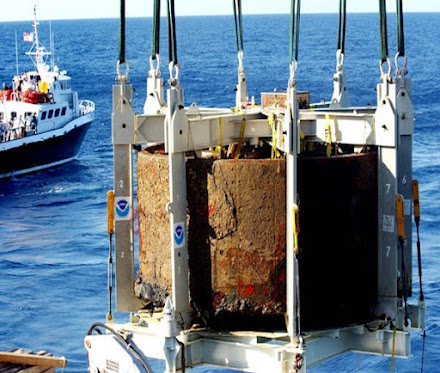 |
| Cheers erupted when the USS Monitor turret was brought up in 2002 (NOAA) |
The operation
utilized an eight-legged contraption dubbed the "Spider," which locked around the
upside-down turret and lifted it from the ocean floor, 140 years after the USS
Monitor sank during a storm off Cape Hatteras.
The National
Oceanic and Atmospheric Administration (NOAA), the U.S. Navy and the Mariners’
Museum and Park in Newport News, Va., where the giant artifact has been in a
conservation tank since its recovery, this week have been recalling the
momentous turret recovery.
A webinar about recovery of the ironclad’s principal components was held Tuesday.
The museum on Saturday will mark the 20th anniversary (NOAA image left), with programs set from 10 a.m.-3 p.m. ET. Speakers include Will Hoffman, chief conservator of the Monitor, and John Broadwater, who was part of recovery operations. You can find more details about the events here.
The Mariners’
Museum has been conserving the vessel’s two large Dahlgren guns. Responding to a
Facebook question this week about the turret’s orientation, officials said:
“The turret
will be flipped right side up in the next year or two to continue conservation
work, so we should definitely be able to display it correctly. The guns will
most likely be displayed separately since we will want to do everything we can
to preserve all of the artifacts.”
While much of the USS Monitor’s wreckage has remained on the
ocean floor since Dec. 31, 1862, the turret, guns, anchor, engine components
and thousands of artifacts are housed at the Mariners’ Museum.
Researchers found the wreckage of the USS Monitor in 1973 and subsequent trips included the recovery of a famous lantern and anchor. Between 1998 and
2001, most of the engine room was excavated and brought ashore.
Hoffman, in a blog post this week, wrote about the unique and meticulous recovery involving divers and crews in a barge above.
 |
| The turret carried two Dahlgren guns (Mariners' Museum and Park) |
The turret popped to the surface with much fanfare on Aug. 5, 2002. The
artifact was brought to Newport News a few days later, greeted by pleasure
boats and a 21-gun salute. The turret was then trucked to the museum in an informal parade.
The USS Monitor revolutionized naval warfare.
 |
| A specially built "spider" lifted the turret from 230 feet (NOAA) |
But the small ship quickly challenged the
heavily armored CSS Virginia upon arrival and ended the latter’s rampage
against Federal ships. The stalemate foreshadowed the end of wooden warships.
An expedition in May, utilizing an underwater robot, visited the USS Monitor and other shipwrecks in the Monitor National Marine Sanctuary. According to media reports, officials said the ironclad was in better shape than expected, probably because of its superior construction.
 |
| NOAA schematic shows a portion of the turret under the ship's armor belt |
The
answer to those questions "was a resounding 'No'," Casserley told McClatchy News.
 |
| The Monitor turret before its recovery in summer 2022 (NOAA) |

No comments:
Post a Comment